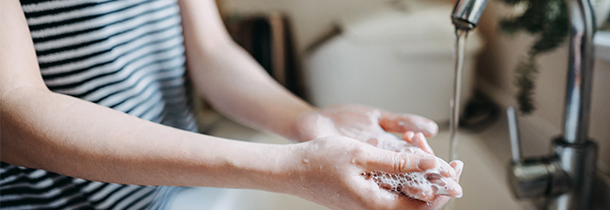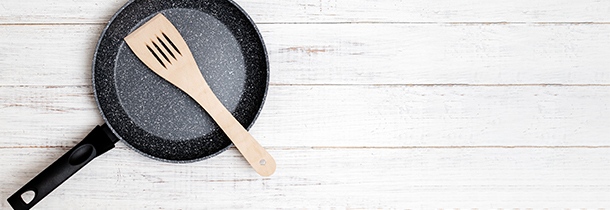12 Kitchen Safety Tips

Of all the rooms in your home, the kitchen presents the most safety hazards due to the number of appliances and heat sources. From fires to unsafe food preparation, the threat to health and safety is real. We have a few tips to keep in mind so you can help make your kitchen a safer environment for the entire family.
1. Install GFCI Outlets
 Ground-Fault Circuit Interrupter (GFCI) Outlets help protect from electric shock. They are required by the National Electrical Code® (NEC®) in wet/damp locations of the home and the kitchen certainly qualifies. With appliances often in close proximity to a water source (think the coffee maker on the counter near the sink), the chance of a shock event happening is more common than you may realize. GFCI Outlets detect ground-faults that can lead to electric shock and work to cut off power BEFORE a shock can occur – protecting you from a potentially dangerous situation.
Ground-Fault Circuit Interrupter (GFCI) Outlets help protect from electric shock. They are required by the National Electrical Code® (NEC®) in wet/damp locations of the home and the kitchen certainly qualifies. With appliances often in close proximity to a water source (think the coffee maker on the counter near the sink), the chance of a shock event happening is more common than you may realize. GFCI Outlets detect ground-faults that can lead to electric shock and work to cut off power BEFORE a shock can occur – protecting you from a potentially dangerous situation.
2. Consider Dimmers
 Dimmers offer the ideal solution for safe kitchen lighting. Because you can adjust the light level from dim to full bright, dimmers make it easy to customize lighting for any activity. When cooking or preparing meals, more light is better. When sitting down to eat, lights can be dimmed to create ambiance and provide a relaxed atmosphere.
Dimmers offer the ideal solution for safe kitchen lighting. Because you can adjust the light level from dim to full bright, dimmers make it easy to customize lighting for any activity. When cooking or preparing meals, more light is better. When sitting down to eat, lights can be dimmed to create ambiance and provide a relaxed atmosphere.
3. Know how to extinguish a fire
There are roughly 164,500 residential cooking fires in the United States each year, making cooking the leading cause of fire and injuries that occur in our homes. This is why it is so important to have a fire extinguisher in your kitchen… and to know how to use it! Fires spread quickly and you may have only seconds to get a fire under control or extinguished before major harm/damage is done. Take some time to educate yourself about the different types of fires, such as grease and electric fires. Never put them out with water. Instead, use baking soda or a pan lid to suffocate the fire. This removes the air that fuels it. A fire inside your oven is best put out with an extinguisher, and a microwave fire can be put out by turning off the appliance and keeping the door closed. As with any fire event, a call to your fire department is essential Even if you are able to extinguish the fire on your own, it is always wise to have a professional firefighter come by to inspect the area and make sure the fire is completely out and the area is safe.

4. Wash your hands
For sanitary reasons, it’s important to wash your hands in hot soapy water before and after cooking. Drying hands with paper towels is safer than using a dish towel, which may become cross contaminated if it touches raw meat or poultry, a leading cause of food poisoning. You should also wash your hands in between touching various ingredients – touch vegetables, wash hands, then touch meat, wash hands – you get the idea. Be sure to also clean all your counter surfaces and sinks where any raw meats or juices may have had contact.
5. Wear safe clothing.
Loose fitting or baggy clothes can be a hazard when cooking. It is particularly wise to avoid wearing long, baggy sleeves in the kitchen or anything with a front facing tie that can become loose (make sure aprons tie in the back). In general, tops with fitted sleeves or no sleeves are safest. Also, avoid wearing anything flammable or synthetic as these fabrics are sensitive to heat and can overheat and melt onto your skin.
6. Prevent burns.
Turning the handles of your pots and pans inward while cooking on the stove helps prevent someone passing by from accidently hitting the handle and knocking the food or boiling water out of the pot into themselves or onto the floor. Additionally, be sure to have potholders or oven mitts close by when cooking anything on the stove top or in the oven. Never assume a pot handle is cool. Did you know wet potholders or dish rags will not keep the heat from burning your hands. Be certain anything you use to touch hot cookware is dry.

7. Learn the ABCs of knives.
Knives come in all lengths and degrees of sharpness. From a paring knife to a meat cleaver, each has its own unique traits for a specific function. Did you know that a dull knife is more likely to slip and cut you than a sharp knife? Therefore, keeping your knives sharpened is one way to keep them safe. Using a knife sharpener periodically is a good way to maintain the blade.
8. Always stir and lift away from you.
To avoid burns, always lift lids and stir pots away from you. Condensation forms on lids during the cooking process and it becomes very hot, so you don’t want it to touch your skin. When stirring, hot liquids can “spit” out of the pot, so better that it lands on the opposite side of where you are standing. The same holds true when using a strainer. Be certain to pour the liquid out of the pot away from you, never toward you.
9. Don’t use the same cutting board for raw meat, fruits and vegetables.
Investing in multiple cutting boards could be the best thing you can do for healthy food preparation. Ideally, you should have separate cutting boards for meats/poultry/seafood and for fruits/vegetables to avoid the dangers of cross contamination. If you only have one cutting board or are improvising by using your countertop, be certain to prepare fruits and veggies first, wash the surface thoroughly, then move on to meats.

10. Don’t use metal utensils on nonstick, Teflon pans
Aside from scratching the nice surface of your non-stick cookware, using metal utensils on Teflon or non-stick pans can cause flaking or chipping of the Teflon. The flakes and chips of Teflon are toxic, and you certainly would not want to get that in your food! The solution: wooden or plastic spoons.
11. Don’t set a hot glass dish on a wet or cold surface.
If you recall from science class, glass expands when it gets warm and shrinks when it cools down. This causes stress and can result in the combustion of glass. The safest place to set a glass lid or cookware is on top of a trivet, cutting board or potholder.
12. Wear shoes.
Protect your feet when cooking. This may sound strange, but should you drop a knife, spill hot water or oil, or break a dish, shoes will help protect your feet from injury.
Remember, safe and healthy kitchen habits provide the best foundation to enjoying a good meal with family and friends!


